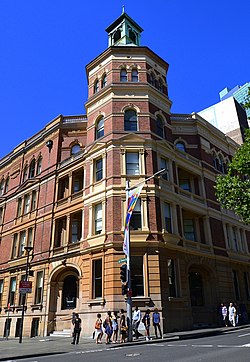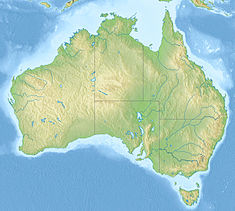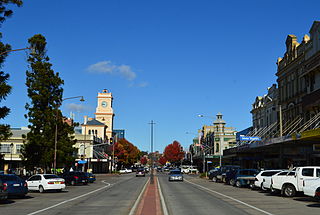
Goulburn is a regional city in the Southern Tablelands of New South Wales, Australia, approximately 195 kilometres (121 mi) south-west of Sydney and 90 kilometres (56 mi) north-east of Canberra. It was proclaimed as Australia's first inland city through letters patent by Queen Victoria in 1863. Goulburn had a population of 24,565 as of the 2021 census. Goulburn is the seat of Goulburn Mulwaree Council.

Balmain is a suburb in the Inner West of Sydney, New South Wales, Australia. Balmain is located two kilometres west of the Sydney central business district, in the local government area of the Inner West Council.
The Australian labour movement began in the early 19th century and since the late 19th century has included industrial and political wings. Trade unions in Australia may be organised on the basis of craft unionism, general unionism, or industrial unionism. Almost all unions in Australia are affiliated with the Australian Council of Trade Unions (ACTU), many of which have undergone a significant process of amalgamations, especially in the late 1980s and early 1990s. The leadership and membership of unions hold and have at other times held a wide range of political views, including socialist, democratic and right-wing views.

The Goulburn Correctional Centre,, is an Australian supermaximum security prison for males. It is located in Goulburn, New South Wales, three kilometres north-east of the central business district. The facility is operated by Corrective Services NSW. The Complex accepts prisoners charged and convicted under New South Wales and/or Commonwealth legislation and serves as a reception prison for Southern New South Wales, and, in some cases, for inmates from the Australian Capital Territory.

James Sinclair Taylor McGowen was an Australian politician. He served as premier of New South Wales from 1910 to 1913, the first member of the Australian Labor Party (ALP) to hold the position, and was a key figure in the party's early history in New South Wales.

Goulburn railway station is a heritage-listed railway station on the Main Southern line in New South Wales, Australia. Opened on 19 May 1869, it serves the city of Goulburn. It was added to the New South Wales State Heritage Register on 2 April 1999.
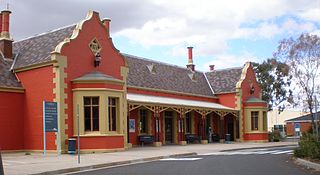
Bathurst railway station is a heritage-listed railway station located on Havannah Street, Bathurst, New South Wales, Australia. It is situated on the Main Western line and is the only railway station serving the city. The station was added to the New South Wales State Heritage Register on 2 April 1999.
Australian non-residential architectural styles are a set of Australian architectural styles that apply to buildings used for purposes other than residence and have been around only since the first colonial government buildings of early European settlement of Australia in 1788.

The St Saviour's Cathedral is the heritage-listed cathedral church of the Anglican Diocese of Canberra and Goulburn in Goulburn, Goulburn Mulwaree Council, New South Wales, Australia. The cathedral is dedicated to Jesus, in his title of Saviour. The current dean is the Very Reverend Gavin Krebs. It was added to the New South Wales State Heritage Register on 20 April 2009.

Hong Kong House, also known since 1995 as the Hong Kong Economic and Trade Office, Sydney, is a landmark heritage building and former hotel in the Sydney central business district, City of Sydney, New South Wales, Australia. Built in 1891 to a design by Ambrose Thornley, it is located on 80 Druitt Street, at the corner with York Street, and is adjacent to other prominent heritage landmarks, the Sydney Town Hall and the Queen Victoria Building. Formerly known as Gresham Hotel, the property was added to the New South Wales State Heritage Register on 2 April 1999.

Mort's Dock is a former dry dock, slipway, and shipyard in Balmain, New South Wales, Australia. It was the first dry dock in Australia, opening for business in 1855 and closing more than a century later in 1959. The site is now parkland.

The Labor Council of New South Wales, branded Unions NSW, is the peak body for trade unions in the state of New South Wales, Australia. As of 2005 there are 67 unions and 8 Rural and Regional Trades & Labor Councils affiliated to the Labor Council, representing 800,000 workers in NSW. It is registered as the State Peak Council of Employees under Section 215 of the Industrial Relations Act 1996 (NSW). The council is affiliated with the Australian Council of Trade Unions (ACTU).

The Waterloo Town Hall is a heritage-listed town hall located in Waterloo, a suburb of Sydney, New South Wales, Australia. Located at 770 Elizabeth Street, it was built in 1880–82 in the Victorian Italianate architectural style with Second Empire elements by John Smedley, Edward Hughes and Ambrose Thornley. The town hall was the seat of Waterloo Municipal Council from 1882 to 1948 and since 1972 has been the Waterloo Library, a branch of the City of Sydney Library servicing Waterloo and Alexandria.

Bank of New South Wales Building is a former heritage-listed bank at 101–111 Flinders Street, Townsville CBD, City of Townsville, Queensland, Australia. It was built in 1887 by Denis Kelleher. It is also known as Australian Meat Industry Employees Union. It was added to the Queensland Heritage Register on 21 October 1992.

Kenmore Asylum, also known as Kenmore Hospital or Kenmore Psychiatric Hospital is a heritage-listed decommissioned psychiatric hospital located in Goulburn, a town in New South Wales, Australia. Construction began in 1894 and opened in 1895, capable of housing 700 patients. In March 1941, the Australian Army accepted an offer from the New South Wales Government, where the Kenmore Asylum would be the site for a military hospital. As a result, patients located at the asylum were moved to various mental institutions in Sydney. In 1946, the Australian Department of Health resumed control of Kenmore Asylum after the army moved out. The property was sold in 2003 and resold in 2010. It is described as one of Australia's "most haunted locations".
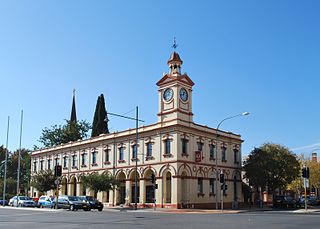
Albury Post Office is a heritage-listed post office at 570 Dean Street, Albury, in the Riverina region of New South Wales, Australia. It was designed by NSW Colonial Architects Office under James Barnet and built in 1880. The property is owned by Australia Post. It was added to the New South Wales State Heritage Register on 17 December 1999. On 8 November 2011 the building was listed on the Commonwealth Heritage List; and is listed on the Register of the National Estate since 21 March 1978.
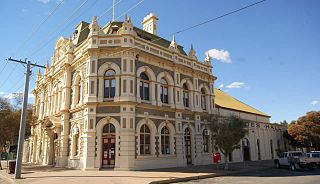
The Broken Hill Trades Hall is a heritage-listed trades hall at 34 Sulphide Street, Broken Hill in the Far West of New South Wales, Australia. It was designed by Tom Jackson and built from 1898 to 1905. The property is owned by the Trades Hall Trust. It was added to the New South Wales State Heritage Register on 2 April 1999.

Goulburn Post Office is a heritage-listed post office at 165 Auburn Street, Goulburn, New South Wales, Australia. It was designed by Colonial Architect James Barnet and built from 1880 to 1881 by F. Horn. It is also known as Goulburn Post and Telegraph Office. The property is owned by Australia Post.

St Peter and Paul's Old Cathedral is a heritage-listed former Catholic cathedral and now parish church at 42 Verner Street, Goulburn, Goulburn Mulwaree Council, New South Wales, Australia. It was designed by Andrea Stombuco and Charles Spadacini and built from 1871 to 1890 by C. J. O'Brien and Wilkie Bros. It is also known as St. Peter and Paul's Former Cathedral and St Peter and Paul's Catholic Cathedral; Saints Peter and Paul's Catholic Cathedral. It was added to the New South Wales State Heritage Register on 20 April 2009.
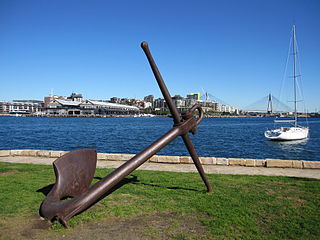
Iloura Reserve is a heritage-listed public reserve on the site of a former timber yard at 10–20 Weston Street, Balmain East, Inner West Council, Sydney New South Wales, Australia. Following the resumption of the timber yard for public space in the 1960s, the present reserve was designed and laid out by landscape architect Bruce Mackenzie and constructed in two stages: stage one in 1970 and stage two in 1981. It is also known as Peacock Point and Illoura. The reserve is owned by the Inner West Council. It was added to the New South Wales State Heritage Register on 29 November 2013.
